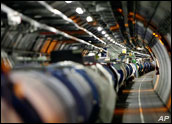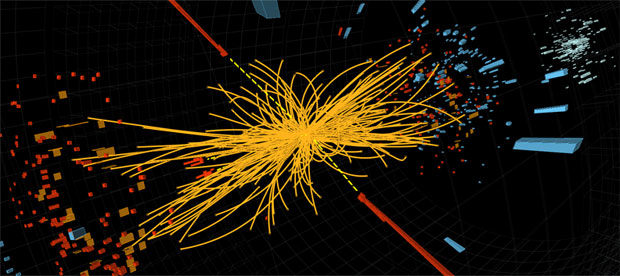
After years of searching, particle physicists say they have all but certainly pinned down the elusive Higgs boson. Popularly known as the “God particle,” this boson will help provide a better understanding of how most of the particles of nature acquire their mass, improving physicists’ understanding of the universe.

Scientists working on the Atlas and CMS experiments conducted by CERN, the European organization for nuclear research, have announced that their data indicates clear signs of a new particle that is likely the Higgs boson.
The Game’s Afoot
Signs of a new particle, at the level of 5 sigma were observed in the mass region at about 126 GeV, Atlas spokesperson Fabiola Gianotti announced.
The Standard Model of particle physics predicts that a Higgs boson will decay into different particles. The Atlas and CMS experiments were set up to detect those particles.
A GeV is a giga-electron volt. In physics, an electron volt is the amount of energy gained by the charge of a single electron moved across an electric potential difference of one volt. This energy is used as a unit of momentum in high-energy physics. Dividing energy in eV by the speed of light in vacuum lets physicists describe the momentum of an electron.
The term “sigma” is a statistical measure used to express the probability of a statistical fluke when the results of an experiment don’t match up with theory.
Five sigmas indicate there’s one chance in 3.5 million that statistical fluctuations are to blame for the mismatch. Three sigmas correspond to one chance in 740 of a statistical fluctuation; four sigmas one chance in 32,000.
“Five sigma is the accepted level of significance for a discovery,” Gail Hanson, a distinguished professor at the University of California Riverside, who’s working at CERN in Geneva now, told TechNewsWorld. “We have all seen 3 sigma signals disappear in subsequent measurements.”
The results from the tests were preliminary, CERN noted. Data is still under review, and the complete analysis is expected to be complete by the end of July.
Putting Salt on the Higgs’ Tail
Higgs bosons can be produced in different ways, each of which has different features. These production methods include the Drell-Yan process, vector boson fusion, and gluon fusion.
The Higgs boson can decay into a bottom quark and antiquark pair. Or they can decay into other products, including WW (charged) or ZZ (neutral) pairs, tau-lepton pairs and photon pairs. Bottom quarks have a bare mass slightly more than four times that of a proton. This, together with other factors, makes them relatively easy to identify.
“One looks for an excess at a particular mass for combinations of the decay products of W and Z bosons,” UC Riverside”s Hanson said. “This leads to the search in combinations such as two positrons and two electrons, or an electron and a positron and a positive muon and a negative muon.”
Higgs bosons can “decay in different ways, with different probabilities,” Jacobo Konigsberg, a professor at the University of Florida who’s worked at the CERN CMS experiment, told TechNewsWorld.
That means there are different ways to look for the Higgs boson. Phycists at the Tevatron in the United States “focus mostly on the decay to b-quark pairs because, at low Higgs mass, this is the best way to look for [the Higgs],” Konigsberg continued. “At the LHC we look for it that way as well, but other ways turn out to be easier to establish earlier observations with, as was the case.”
More analysis of the data from Atlas and CMS is required before scientists can positively pronounce that the Higgs boson has been discovered.
“The predicted properties of the Higgs boson, such as decay modes and spin, are very specific, and the only thing not known is its mass,” James Bensinger, professor of physics at Brandeis University, told TechNewsWorld. “You have to not only see a new particle but you have to verify that all of its properties are exactly as predicted.”






















































Eppur Si Muove, Higgs Particle YOK
Regardless Of Whatever Whoever
Regardless Of Whatever Is Said By Whoever Says It –
Higgs Particle YOK.
S Hawking is simply wrong in accepting it. Obviously wrong.
Everyone who accepts the story of the Higgs particle is simply wrong.
Plain commonsense.
Singularity and the Big Bang MUST have happened with the smallest base universe particles, the gravitons, that MUST be both energy and mass, even if they are inert mass just one smallest fraction of a second at singularity. All mass formats evolve from gravitons that convert into energy i.e. extricate from their gravitons clusters into mass formats in motion, energy. And they all end up again as mass in a repeat singularity.
Universe expansion and re-contraction proceed simultaneously..
Dov Henis (comments from 22nd century)
http://universe-life.com/
http://universe-life.com/2012/02/03/universe-energy-mass-life-compilation/